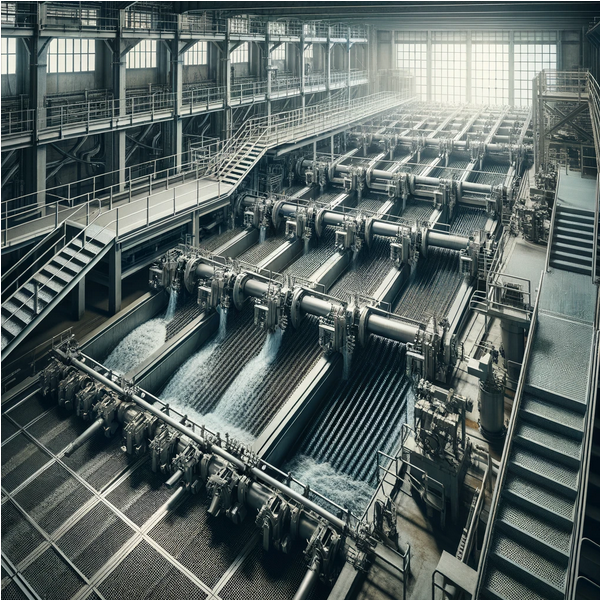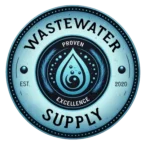
Comparison of Manual and Automatic Bar Screens: Guide to Bar and Automatic Bar Screens
Welcome to Waste Water Supply’s comprehensive guide on bar screens. In this detailed comparison, explore the distinctions between manual and automatic bar screens, focusing on their operational efficiencies, maintenance requirements, and suitability for various wastewater treatment applications. Understanding these differences is crucial for optimizing performance and ensuring the reliability of your water treatment processes. Dive in to discover which type of bar screen best meets your facility’s demands.
Importance of Manual and Automatic Bar Screens in Wastewater Treatment
In wastewater treatment, bar screens play a vital role in ensuring operational efficiency and maintaining the integrity of treatment plants. Manual bar screens and automatic bar screens are integral components of a comprehensive screening system designed to remove large debris and solids from water before the treatment process. The importance of these screens cannot be overstated, as they are the forefront defense against pollutants that could clog pumps and damage downstream equipment.
Manual bar screens are typically utilized in smaller treatment plants or as backup systems. They require human intervention to remove the collected debris, which can be labor-intensive but cost-effective in terms of initial investment. These screens are often installed with lower flow and load conditions, making them suitable for rural or smaller municipal systems. Conversely, automatic bar screens are employed in larger, high-capacity plants where continuous operation is paramount. These systems use mechanical rakes to automatically remove debris, significantly reducing labor costs and ensuring uninterrupted flow.
The design and engineering of manual bar screens and automatic bar screens are crucial to their effectiveness. Both screens must be durable and resistant to corrosion, as they operate in harsh environments. While manual bar screens offer simplicity and low maintenance, automatic bar screens provide higher efficiency and improved operational reliability. They can handle larger volumes of debris with minimal human intervention, essential for maintaining the smooth operation of large-scale wastewater treatment plants.
Debris and solids intercepted by these screens are typically removed from the water flow, ensuring that subsequent treatment processes are not hindered. This initial screening step is critical to preventing damage to pumps and other essential treatment equipment, which can result in costly repairs and downtime. Furthermore, efficient screening reduces the amount of solids entering the biological treatment phase, enhancing the overall treatment process and improving the treated water quality.
Selecting the appropriate type of bar screen—whether manual or automatic—depends on various factors, including the size of the treatment plant, the volume of water to be treated, and budget constraints. Each system offers distinct advantages and disadvantages, and understanding these can help make an informed decision that enhances the operational efficiency of the water treatment plant.
In conclusion, manual bar screens and automatic bar screens are indispensable in wastewater treatment. Their ability to remove debris and solids from water is crucial for the protection and efficiency of treatment systems. As engineering advancements continue, these screens will become more effective, contributing significantly to the environmental protection and operational success of wastewater treatment plants.
Types and Applications of Manual Bar Screen and Automated Bar Screens
In water treatment and wastewater treatment, manual bar screens and automated bar screens play a critical role in ensuring the efficient removal of debris and solids from the water. Understanding the types and applications of these bar screens is crucial in enhancing the overall effectiveness of the treatment process. Manual bar screens, also known as manual bars, involve manual operations to remove trapped debris. This screening system is typically used in smaller facilities where the water volume and the debris amount are manageable. The primary application of the manual bar screen lies in its cost-effectiveness and simplicity, making it a suitable choice for facilities with limited budgets and lower flow rates.
However, for larger water and wastewater treatment plants, automated bar screens, also called automated coarse screens, offer a more efficient and less labor-intensive solution. These automated bar screens utilize mechanical systems to automatically remove debris, reducing the need for manual intervention. The main advantage of automated bar screens is their ability to handle higher volumes of water and larger amounts of debris, thus enhancing the overall efficiency of the screening process. These types of bar screens are integrated into advanced treatment systems and are often employed in facilities with high sludge production and rigorous treatment requirements.
Different strategies are employed in designing and implementing manual and automated bar screens. Manual bar screens require frequent maintenance to ensure efficient separation of solids, whereas automated systems have built-in mechanisms for routine operation, allowing for continuous and uninterrupted screening. The choice between manual bar screens and automated bar screens depends on various factors, such as the scale of the treatment plant, budgetary constraints, and specific treatment needs.
Applying the right type of bar screen can significantly impact the system’s overall performance, minimizing potential issues such as clogging and equipment damage. For example, automated bar screens are especially useful in systems where high screening volumes are necessary and manual monitoring is impractical. In contrast, manual bar screens might be more advantageous in smaller setups where automation is unjustified. Both screens are essential components in water treatment and wastewater treatment strategies, tailored to meet different operational requirements.
In conclusion, comparing manual and automated bar screens illustrates the diversity and specificity of screening solutions available. Each type has its distinct applications and benefits, directly influencing the efficiency and effectiveness of water and wastewater treatment processes. Choosing the right product, whether it’s a manual bar screen or an automated bar screen, ensures optimal removal of debris and contributes to the systematic functionality of the entire treatment operation.
Selection Criteria for Manual Bar Screens and Automated Bar Screens
Choosing between manual bar screens and automatic bar screens for wastewater treatment involves several critical factors and requirements. Understanding these criteria is essential for optimal water screening performance and effectively handling solids and debris in industrial applications. Manual bar screens, commonly called manual screens, are typically used when cost and simplicity are primary considerations. They are efficient in capturing large materials and heavy debris before they can cause damage to downstream equipment. Despite their effectiveness, the type and design should be selected based on the specific water flow rates and the nature of the debris.
Compared to manual bar screens, automatic bar screens are increasingly preferred for their advanced technology and ability to handle significant volumes of wastewater with less human intervention. Using automatic bar screens is advantageous in scenarios where continuous operation is required, thus reducing the time and labor associated with manual screens. Automatic bar screens are equipped with sophisticated sensors and automated cleaning mechanisms that efficiently remove accumulated debris without manual handling, ultimately lowering the maintenance requirements and associated costs.
When comparing both types, consider the nature and volume of the solids and debris that must be screened. Fine screens, a subset of manual and automatic bar screens, are particularly effective in screening fine particles and smaller debris, ensuring a higher quality of water treatment. Material selection for bar screens is also pivotal; screens made from durable and corrosion-resistant materials ensure long-lasting performance and less frequent replacements. Maintenance is another significant criterion; while manual bar screens necessitate regular manual cleaning and inspection, automatic bar screens offer an almost maintenance-free operation with periodic checks.
The strategies for selecting between these two types of bar screening products should also consider available infrastructure and budgetary constraints. For facilities with limited manpower and extensive water treatment demands, automatic bar screens provide a technologically advanced solution. Conversely, manual bar screens offer a cost-effective yet robust option in settings where budget limitations exist. Considering the maintenance and time investment involved, it’s important to weigh the pros and cons of each type. Additionally, advancements in water and bar screening technology may influence decision-making process.
In conclusion, whether opting for manual bar screens or automatic bar screens, it’s crucial to evaluate the specific requirements of your wastewater treatment process, considering aspects like debris load, maintenance capacity, and long-term operational goals. Manual bar screens may be favorable for simpler applications with lower maintenance demands, while automatic bar screens are ideal for high-volume, continuous operations that benefit from sophisticated, less labor-intensive technologies. Making an informed decision ensures enhanced efficiency and sustainability in wastewater management.
Technological Innovations in Water Screening and Bar Screening
In recent years, wastewater treatment has seen remarkable technological innovations in water screening and bar screening processes. These advancements, ranging from manual bar screens to highly automated bar screens, have revolutionized the efficiency, reliability, and operational capabilities of treatment plants. Implementing cutting-edge technology in water and bar screening systems has enabled wastewater treatment facilities to manage higher volumes of waste with greater precision and minimal human intervention.
Automated bar screens represent a significant leap forward in the engineering and design of screening equipment. By leveraging the latest technological advancements, these screens can handle varying wastewater flow rates and more demanding operational requirements. These systems’ primary benefits are their ability to deliver consistent performance and reduce labor costs, making them ideal for large industrial plant applications.
Manual bar screens, however, still hold a prominent place in many wastewater treatment facilities. Though they require more hands-on management, they are often used in smaller-scale operations or as a backup to more automated systems. The type of bar screen employed in a treatment plant typically depends on the specific needs and scale of the facility, as well as budgetary constraints.
Modern water screening technologies have introduced more advanced screening techniques that substantially improve debris separation from water. These systems can be customized to meet specific treatment protocols and environmental regulations. Innovations in screen design and material, such as fine screens and ultra-fine screens, allow for better debris removal, directly impacting the treatment system’s overall efficiency.
Introducing hybrid systems that combine elements of manual and automated screens offers a versatile solution, especially in facilities where redundancy and reliability are critical. By integrating advanced technology and smart controls, these systems can optimize screening efficiency while adapting to changing plant requirements.
In summary, the landscape of wastewater treatment has been considerably enhanced by technological innovations in bar screening and water screening. As Waste Water Supply continues to pioneer in this field, it remains committed to delivering top-tier engineering services and state-of-the-art products that meet the evolving needs of municipal and industrial clients.
In conclusion, the choice between manual and automatic bar screens depends on various factors, such as the size of the wastewater treatment facility, budget constraints, and the level of automation desired. Waste Water Supply provides a comprehensive range of bar screens that cater to diverse operational needs. Manual bar screens may suit facilities seeking cost-effective solutions and minimal maintenance. Conversely, for larger operations that prioritize efficiency and reduced labor, automatic bar screens are recommended. Trust Waste Water Supply to deliver reliable, high-quality wastewater treatment solutions tailored to your requirements.
